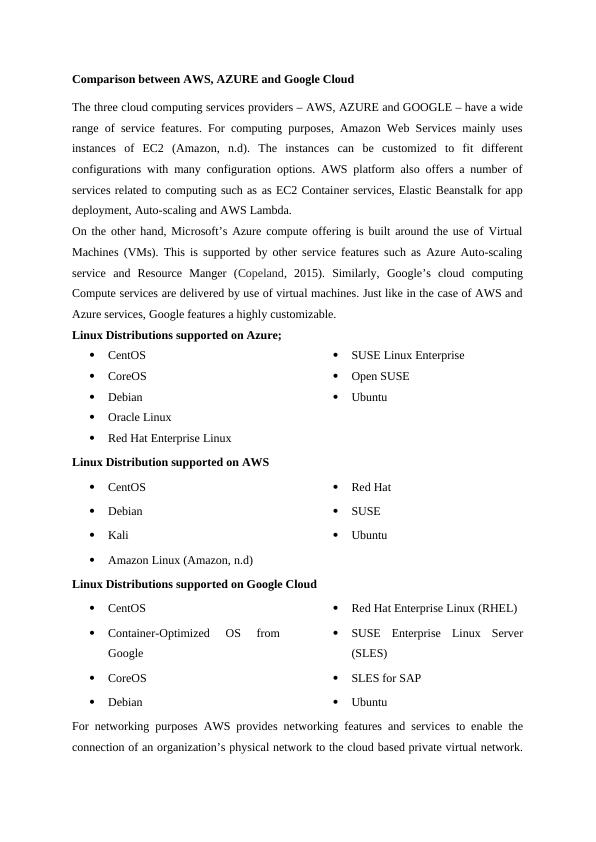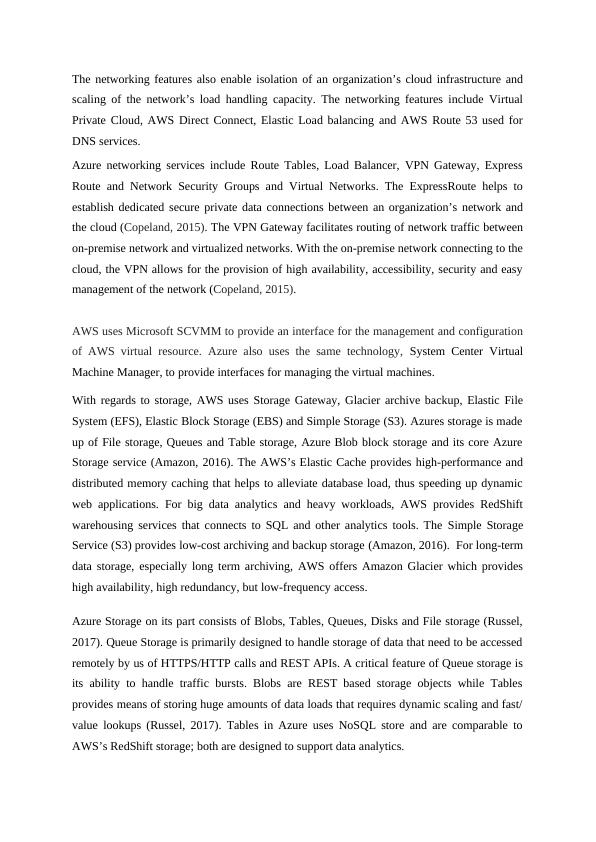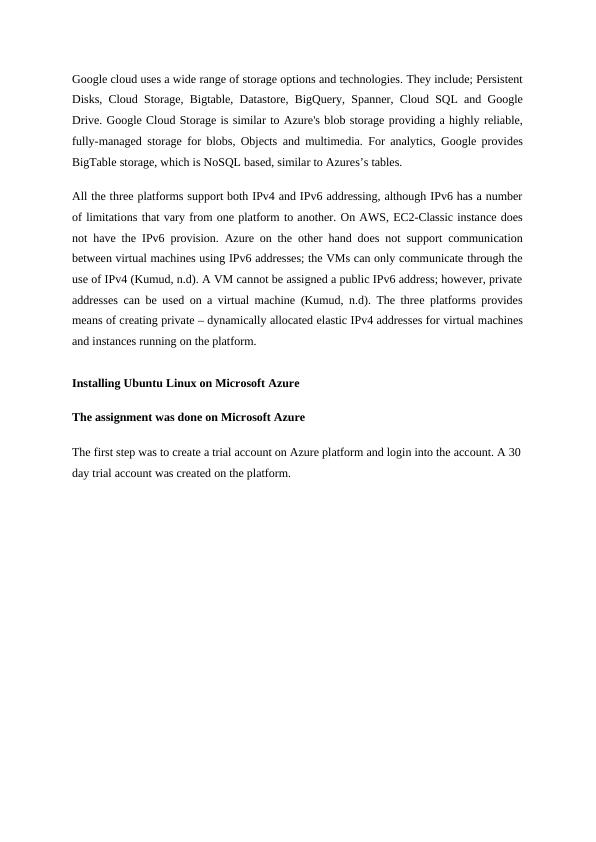Cloud Computing Services Providers Assignment
19 Pages2052 Words68 Views
Added on 2020-04-01
Cloud Computing Services Providers Assignment
Added on 2020-04-01
ShareRelated Documents
Practical Assignment Part 2AWS, AZURE and Google Cloud<Name><Institution>

Comparison between AWS, AZURE and Google CloudThe three cloud computing services providers – AWS, AZURE and GOOGLE – have a widerange of service features. For computing purposes, Amazon Web Services mainly usesinstances of EC2 (Amazon, n.d). The instances can be customized to fit differentconfigurations with many configuration options. AWS platform also offers a number ofservices related to computing such as as EC2 Container services, Elastic Beanstalk for appdeployment, Auto-scaling and AWS Lambda. On the other hand, Microsoft’s Azure compute offering is built around the use of VirtualMachines (VMs). This is supported by other service features such as Azure Auto-scalingservice and Resource Manger (Copeland, 2015). Similarly, Google’s cloud computingCompute services are delivered by use of virtual machines. Just like in the case of AWS andAzure services, Google features a highly customizable. Linux Distributions supported on Azure;CentOSCoreOSDebianOracle LinuxRed Hat Enterprise LinuxSUSE Linux EnterpriseOpen SUSEUbuntuLinux Distribution supported on AWSCentOSDebianKaliAmazon Linux (Amazon, n.d)Red HatSUSEUbuntuLinux Distributions supported on Google CloudCentOSContainer-Optimized OS fromGoogleCoreOSDebianRed Hat Enterprise Linux (RHEL)SUSE Enterprise Linux Server(SLES)SLES for SAPUbuntuFor networking purposes AWS provides networking features and services to enable theconnection of an organization’s physical network to the cloud based private virtual network.

The networking features also enable isolation of an organization’s cloud infrastructure andscaling of the network’s load handling capacity. The networking features include VirtualPrivate Cloud, AWS Direct Connect, Elastic Load balancing and AWS Route 53 used forDNS services. Azure networking services include Route Tables, Load Balancer, VPN Gateway, ExpressRoute and Network Security Groups and Virtual Networks. The ExpressRoute helps toestablish dedicated secure private data connections between an organization’s network andthe cloud (Copeland, 2015). The VPN Gateway facilitates routing of network traffic betweenon-premise network and virtualized networks. With the on-premise network connecting to thecloud, the VPN allows for the provision of high availability, accessibility, security and easymanagement of the network (Copeland, 2015). AWS uses Microsoft SCVMM to provide an interface for the management and configurationof AWS virtual resource. Azure also uses the same technology, System Center VirtualMachine Manager, to provide interfaces for managing the virtual machines. With regards to storage, AWS uses Storage Gateway, Glacier archive backup, Elastic FileSystem (EFS), Elastic Block Storage (EBS) and Simple Storage (S3). Azures storage is madeup of File storage, Queues and Table storage, Azure Blob block storage and its core AzureStorage service (Amazon, 2016). The AWS’s Elastic Cache provides high-performance anddistributed memory caching that helps to alleviate database load, thus speeding up dynamicweb applications. For big data analytics and heavy workloads, AWS provides RedShiftwarehousing services that connects to SQL and other analytics tools. The Simple StorageService(S3) provides low-cost archiving and backup storage (Amazon, 2016).For long-termdata storage, especially long term archiving, AWS offers Amazon Glacier which provideshigh availability, high redundancy, but low-frequency access.Azure Storage on its part consists of Blobs, Tables, Queues, Disks and File storage (Russel,2017). Queue Storage is primarily designed to handle storage of data that need to be accessedremotely by us of HTTPS/HTTP calls and REST APIs. A critical feature of Queue storage isits ability to handle traffic bursts. Blobs are REST based storage objects while Tablesprovides means of storing huge amounts of data loads that requires dynamic scaling and fast/value lookups (Russel, 2017). Tables in Azure uses NoSQL store and are comparable toAWS’s RedShift storage; both are designed to support data analytics.

Google cloud uses a wide range of storage options and technologies. They include; PersistentDisks, Cloud Storage, Bigtable, Datastore, BigQuery, Spanner, Cloud SQL and GoogleDrive. Google Cloud Storage is similar to Azure's blob storage providing a highly reliable,fully-managed storage for blobs, Objects and multimedia. For analytics, Google providesBigTable storage, which is NoSQL based, similar to Azures’s tables. All the three platforms support both IPv4 and IPv6 addressing, although IPv6 has a numberof limitations that vary from one platform to another. On AWS, EC2-Classic instance doesnot have the IPv6 provision. Azure on the other hand does not support communicationbetween virtual machines using IPv6 addresses; the VMs can only communicate through theuse of IPv4 (Kumud, n.d). A VM cannot be assigned a public IPv6 address; however, privateaddresses can be used on a virtual machine (Kumud, n.d). The three platforms providesmeans of creating private – dynamically allocated elastic IPv4 addresses for virtual machinesand instances running on the platform. Installing Ubuntu Linux on Microsoft AzureThe assignment was done on Microsoft AzureThe first step was to create a trial account on Azure platform and login into the account. A 30day trial account was created on the platform.

End of preview
Want to access all the pages? Upload your documents or become a member.
Related Documents
Assignment Linux Server Administrationlg...
|5
|667
|48
Linux Server Administration - Amazonlg...
|20
|1255
|165
Amazon Web Services (AWS) | Assignmentlg...
|4
|1024
|308
ITC514 Linux Server Administration Assignmentlg...
|21
|2602
|205
Report on Linux Server Administrationlg...
|4
|679
|46
Linux Hosting & Virtual Machine Managementlg...
|15
|2640
|92
